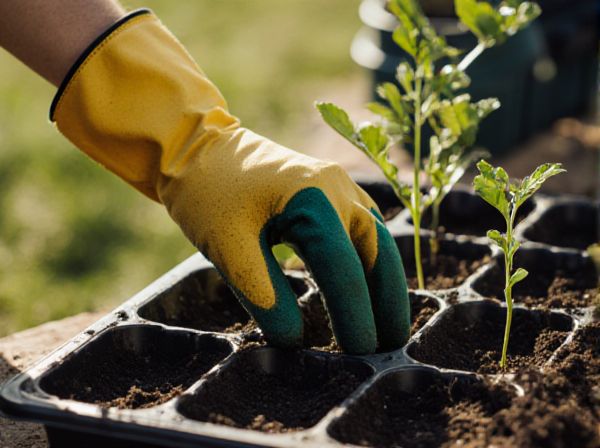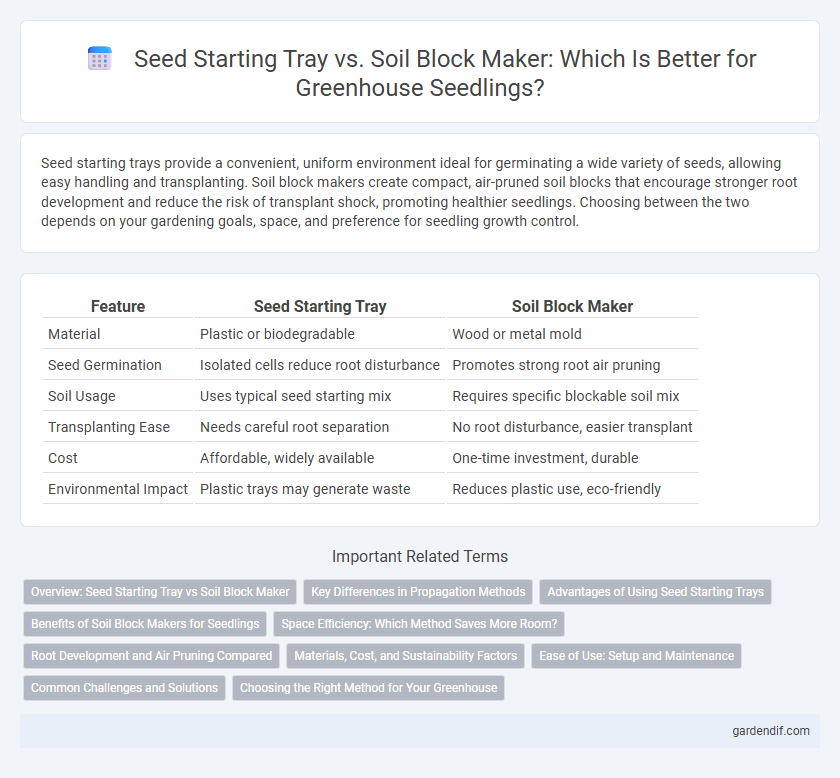
Seed starting tray vs Soil block maker Illustration
Seed starting trays provide a convenient, uniform environment ideal for germinating a wide variety of seeds, allowing easy handling and transplanting. Soil block makers create compact, air-pruned soil blocks that encourage stronger root development and reduce the risk of transplant shock, promoting healthier seedlings. Choosing between the two depends on your gardening goals, space, and preference for seedling growth control.
Table of Comparison
| Feature | Seed Starting Tray | Soil Block Maker |
|---|---|---|
| Material | Plastic or biodegradable | Wood or metal mold |
| Seed Germination | Isolated cells reduce root disturbance | Promotes strong root air pruning |
| Soil Usage | Uses typical seed starting mix | Requires specific blockable soil mix |
| Transplanting Ease | Needs careful root separation | No root disturbance, easier transplant |
| Cost | Affordable, widely available | One-time investment, durable |
| Environmental Impact | Plastic trays may generate waste | Reduces plastic use, eco-friendly |
Overview: Seed Starting Tray vs Soil Block Maker
Seed starting trays provide structured compartments that allow precise control of soil moisture and root space, promoting uniform seed germination in greenhouse environments. Soil block makers create compressed soil blocks without plastic, enhancing root aeration and reducing transplant shock by allowing roots to grow naturally without container boundaries. Both tools optimize early seedling growth, yet seed trays are preferred for ease of handling and water retention, while soil block makers support sustainable practices and healthier root development.
Key Differences in Propagation Methods
Seed starting trays provide individual cells for sowing seeds, offering uniform spacing and easy handling for consistent germination. Soil block makers compress soil into compact blocks without containers, promoting healthier root growth and reducing transplant shock due to better aeration and drainage. The choice between these tools impacts seedling development, with trays favoring convenience and soil blocks enhancing root structure and sustainability.
Advantages of Using Seed Starting Trays
Seed starting trays offer superior control over soil moisture and temperature, promoting optimal germination rates and healthier seedlings. Their uniform cell structure facilitates consistent root development and easy transplanting, reducing seedling shock compared to soil block makers. Durable materials and reusable designs make seed starting trays a cost-effective and sustainable choice for greenhouse propagation.
Benefits of Soil Block Makers for Seedlings
Soil block makers create air-pruned soil masses that encourage stronger root development and reduce transplant shock by eliminating the need for plastic containers. These blocks improve aeration and moisture retention, promoting healthier, faster-growing seedlings with less risk of root-bound plants. By using soil block makers, greenhouse growers can achieve sustainable, eco-friendly propagation while optimizing space and minimizing waste.
Space Efficiency: Which Method Saves More Room?
Seed starting trays maximize space by allowing many cells in a compact area, ideal for small greenhouses or limited bench space. Soil block makers eliminate the need for traditional pots, reducing container bulk and increasing air circulation around roots, which can lead to healthier seedlings. Overall, soil block makers save more room by removing containers and enabling denser plant spacing compared to seed starting trays.
Root Development and Air Pruning Compared
Seed starting trays provide consistent moisture retention and space for initial root growth but can sometimes lead to root circling due to limited air exposure. Soil block makers naturally promote air pruning by exposing roots to air at the block edges, preventing root spiraling and encouraging a healthier, fibrous root system. This enhanced air pruning with soil blocks boosts aeration and root branching, improving nutrient uptake and overall seedling vigor in greenhouse environments.
Materials, Cost, and Sustainability Factors
Seed starting trays are typically made from plastic or biodegradable materials, offering a lower initial cost but raising concerns about plastic waste and environmental impact. Soil block makers use compacted soil to create blocks, eliminating the need for containers and reducing plastic use, which enhances sustainability but may require higher upfront investment in quality soil or compost. Both options impact environmental sustainability differently, with soil block makers promoting zero-waste gardening practices and seed trays offering convenience and affordability.
Ease of Use: Setup and Maintenance
Seed starting trays offer straightforward setup with pre-formed cells, making planting and transplanting easier, while soil block makers require more preparation but reduce transplant shock by eliminating the need for plastic containers. Maintenance for seed trays involves regular cleaning to prevent disease buildup, whereas soil block makers need simple cleaning but produce biodegradable blocks that minimize waste. Overall, seed starting trays provide convenience for beginners, and soil block makers appeal to gardeners seeking sustainable and low-maintenance options.
Common Challenges and Solutions
Seed starting trays often face issues like poor drainage and root circling, which can stunt seedling growth and reduce transplant success. Soil block makers address these challenges by creating compact, air-pruned soil blocks that promote healthy root systems and improve moisture retention. To optimize seedling development, gardeners should ensure proper watering techniques and use a high-quality mix suitable for both methods.
Choosing the Right Method for Your Greenhouse
Seed starting trays provide consistent moisture retention and easy transplanting for seedlings, making them ideal for beginners managing diverse crops in a greenhouse. Soil block makers offer superior root aeration and reduce transplant shock by eliminating plastic use, promoting healthier root systems suited for organic gardeners. Selecting between trays and soil blocks depends on factors like plant type, environmental control, and sustainability goals within your greenhouse setup.
Seed starting tray vs Soil block maker Infographic

 gardendif.com
gardendif.com